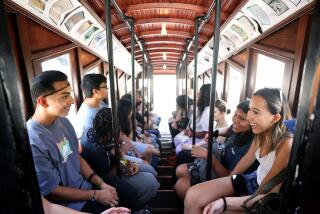Audio time capsule, one story at a time
GEORGE CAYWOOD and his grown daughter, Gina, have always been close, but when a radio microphone was recently placed between them they became even closer.
The Caywoods this month added their distinctive stories to an ambitious national oral history project called StoryCorps whose goal is to amass a library of a quarter-million interviews between ordinary Americans over the next decade. The recorded 40-minute interviews, meant to give future generations an audio glimpse of everyday life in our time, will eventually be pared to two-minute segments to prepare them for archiving in the American Folklife Center at the Library of Congress.
Oral histories are typically taken by professionals and usually center on grand national events. In contrast, StoryCorps is built upon a free-flowing give-and-take in an intimate recording studio, most often between family members or close friends about the common but no less grand themes of the personal life -- birth, death, love and so on.
“What this project tells people is that they matter and they won’t be forgotten,” said Dave Isay, the New York-based radio documentarian who founded the project. “That’s really all anybody wants to know.”
The project, which has just begun a six-month, 10-city national tour, has completed about 5,000 interviews. The tour has made its first stop in the West at the Third Street Promenade in Santa Monica, where it will remain until Feb. 5, when it leaves for San Diego.
Anyone can participate in the project, but reservations are required (www.storycorps.net).
In addition to a 26-city tour launched last summer, the project also has two permanent recording sites in New York -- at Grand Central Station and near the former World Trade Center. Select stories culled from these interviews regularly air Friday mornings on National Public Radio. Santa Monica public radio station KCRW-FM (89.9) will create special programming around the local segments as well.
The Caywoods were among the first to record their interview inside a “MobileBooth,” a converted silver Airstream with state-of-the-art equipment now parked near Wilshire Boulevard and Third Street. Like hundreds of other Southern Californians, they were eager to volunteer for the project.
“I never felt my dad received the respect and appreciation he deserved,” said Gina Caywood, 38, of her 67-year-old father, a chaplain who once was president of the Union Rescue Mission in downtown Los Angeles. “He lives a simple life and doesn’t have a lot of money, and I just wanted to honor him this way.”
And as in most previous interviews, it was the younger generation prodding the older one into the booth -- a familiar pattern, say StoryCorps facilitators who work the recording instruments, keep time and gently guide the interview process.
“I’ve had so many grandparents say to their grandchildren, ‘Oh, my life isn’t interesting, why did you drag me here?’ ” said Piya Kochhar, the facilitator who worked with the Caywoods. “Next thing they know their 40 minutes is up.”
Gina, a human resources manager who lives in Long Beach, has always known her father’s life was interesting and very, very rough. When George was 15, his father committed suicide.
“Back then people dealt with grief differently than they do today,” said Gina. “Nobody had ever asked him how it felt to have his father use his gun to kill himself. He was always so worried about everyone else that I think nobody ever stopped to care about him.”
The conversation produced tears from daughter and father, who said he’d originally received the gun as a gift. “She knew about my father,” said George. “But I don’t think I ever told her about how hard I worked to process the guilt, the shame and the grief, so that it would work for me and not destroy me.”
*
Going to the heart of the matter
THE tearful dynamic is not uncommon. StoryCorps provides participants with suggested questions, most of which are designed to elicit powerful emotional responses. The questions tend to focus on family, love, religion and even health and include: “Do you remember what was going through your head when you first saw me?” “Do you ever think about previous lovers?” and “Do you think about dying?”
“People get in the booth and -- boom -- they start crying,” said Isay, a recipient of a MacArthur Foundation “genius” grant. “We want to get Kleenex to be one of our sponsors.”
Of course, not everybody cries during the experience, but few emerge from it without a new appreciation for their subject.
At 91, Millie Rosenstein and her 63-year-old son, Paul, entered the booth this month, ostensibly to talk about her extensive community involvement in Santa Monica. They did that, but Paul, a former councilman and mayor of Santa Monica, also got something unexpected as he closes in on retirement.
“I walked away with a renewed respect for my mother and a sense of enthusiasm about what kind of life I can look forward to when I retire,” said Paul Rosenstein, a labor union representative. “I found it inspiring.”
Millie welcomed the chance to keep the record straight. “It was terrific,” she said. “Once my generation goes, they are going to be rewriting history like crazy, and that’s just unfortunate.”
It’s all part of the magic of the booth, as Isay puts it.
“People like to be asked questions,” he said. “There’s something about having a microphone that allows them to ask questions that they normally wouldn’t get to ask, and it creates a bond that lasts well beyond the time the recording has stopped.”
More to Read
Sign up for The Wild
We’ll help you find the best places to hike, bike and run, as well as the perfect silent spots for meditation and yoga.
You may occasionally receive promotional content from the Los Angeles Times.






